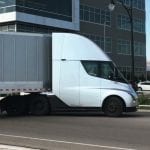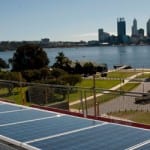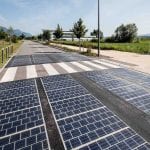Around The Web
Senior Consultant, Corporate Sustainability, South Pole Group – Mexico City/London
Quebec carbon fund ventures in Alberta offsets programme
Gene editing wipes out mosquitoes in the lab
Police consider drones to monitor badger cull protesters
Devon and Cornwall police warn activists as cull zone is massively expanded
Police have warned badger cull protesters that they may use drones to try to keep order in the far south-west of England following heightened tensions between activists and officers.
In an email to protesters seen by the Guardian, a Devon and Cornwall officer said the force would consider using drones “where intelligence dictates”.
Continue reading...Porsche gives up on diesel to set sights on electric and hybrid future
 Porsche will no longer invest in vehicles fueled by diesel, preferring instead to concentrate its efforts on growing electric mobility market.
Porsche will no longer invest in vehicles fueled by diesel, preferring instead to concentrate its efforts on growing electric mobility market.
The post Porsche gives up on diesel to set sights on electric and hybrid future appeared first on RenewEconomy.
Video: Listen to the sound of a Tesla Semi accelerating
 Like a “spaceship taking off:” Watch and listen to the other-wordly sound of a Tesla Semi – trailer attached – accelerating.
Like a “spaceship taking off:” Watch and listen to the other-wordly sound of a Tesla Semi – trailer attached – accelerating.
The post Video: Listen to the sound of a Tesla Semi accelerating appeared first on RenewEconomy.
New study reconciles a dispute about how fast global warming will happen | Dana Nuccitelli
Unfortunately, mainstream climate scientists are still right, and we’re running out of time to avoid dangerous global warming
We’re currently on pace to double the carbon dioxide-equivalent (including other greenhouse gases) in the atmosphere by around mid-century. Since the late 1800s scientists have been trying to answer the question, how much global warming will that cause?
In 1979, top climate scientists led by Jule Charney published a report estimating that if we double the amount of carbon dioxide in the atmosphere from pre-industrial levels of 280 ppm to 560 ppm, temperatures will warm by 3 ± 1.5°C. Four decades later, ‘climate sensitivity’ estimates remain virtually unchanged, but some climate contrarians have argued that the number is at the low end of that range, around 2°C or less.
Continue reading...NZ Market: NZUs stuck in range-bound trade as buyers keep feet off gas
Sydney Opera House offers high-profile boost for Australia’s voluntary carbon market
Where should you move to avoid climate change misery?
Heatwaves, hurricanes and floods will make some places in the US inhospitable
Climate change is fueling heatwaves, hurricanes and floods, gradually making certain places in the US challenging, if not outright miserable, to live in.
Scientists, and some members of the public, are starting to question where in the US will remain comfortable to call home.
Continue reading...Meet the 'climate refugees' who already had to leave their homes
Five people from across the US explain how extreme weather forced them out of their homes – not always to safer ground
Stephen Lipp, who left New Orleans for Houston
Continue reading...Fears grow for small tortoiseshell butterfly as decline continues
Big Butterfly Count records worst summer ever for the species, despite the heatwave providing a boost to most others
Fears are growing for the small tortoiseshell butterfly after this once-common garden insect continued its baffling decline despite the hot summer proving a boon to most species.
The small tortoiseshell suffered its worst summer in the history of the Big Butterfly Count with sightings falling by 32% compared with last year, according to the charity Butterfly Conservation.
Continue reading...Scotland needs tougher policies to meet CO2 targets, say experts
Nicola Sturgeon told more vigorous action needed to achieve post-2020 emissions target
Nicola Sturgeon’s government needs much tougher policies on cutting emissions from Scotland’s roads and farms to meet its ambitious CO2 reduction targets, experts have warned.
The UK government’s committee on climate change (CCC) said the Scottish National party government was well on track to hit its 2020 target to cut emissions by 56%, reducing them faster than the UK as a whole. However, that was largely because of substantial gains from the closure of Scotland’s last coal-fired power station at Longannet in Fife in 2016 and gains from cutting CO2 emissions from waste, which were relatively easy things to achieve.
Continue reading...Revolving doors, golden escalators and the demise of climate and energy policy
 Grattan report details how vested interests are derailing policy in Australia, particularly in energy and climate where there is a revolving door between ministers and industry advisors. It's time to drain the billabong.
Grattan report details how vested interests are derailing policy in Australia, particularly in energy and climate where there is a revolving door between ministers and industry advisors. It's time to drain the billabong.
The post Revolving doors, golden escalators and the demise of climate and energy policy appeared first on RenewEconomy.
AGL slugged with $3m fine for Victorian efficiency certificate shortfall
 AGL falls foul of Victoria energy regulator, again, this time for failing to meet its obligations under the state's energy efficiency scheme.
AGL falls foul of Victoria energy regulator, again, this time for failing to meet its obligations under the state's energy efficiency scheme.
The post AGL slugged with $3m fine for Victorian efficiency certificate shortfall appeared first on RenewEconomy.
W.A.’s Synergy hit by accelerating switch to rooftop solar
 Synergy hit by accelerating shift to rooftop solar, as households and businesses respond to rising grid prices and the removal of subsidies that supported fossil fuels.
Synergy hit by accelerating shift to rooftop solar, as households and businesses respond to rising grid prices and the removal of subsidies that supported fossil fuels.
The post W.A.’s Synergy hit by accelerating switch to rooftop solar appeared first on RenewEconomy.
Solar panels replaced tarmac on a motorway – here are the results
 Solar roads on city streets are just not a great idea.
Solar roads on city streets are just not a great idea.
The post Solar panels replaced tarmac on a motorway – here are the results appeared first on RenewEconomy.
Jaguar I-Pace crosses “Chunnel” on single charge
 With a 369km drive from London to Brussels on a single charge, Jaguar is hoping to put EV range anxiety to rest.
With a 369km drive from London to Brussels on a single charge, Jaguar is hoping to put EV range anxiety to rest.
The post Jaguar I-Pace crosses “Chunnel” on single charge appeared first on RenewEconomy.
Peugeot unveils EV concept based on classic 504
 Peugoet joins race to electric, with a concept of new battery model that pays homage to its classic 504 Coupe.
Peugoet joins race to electric, with a concept of new battery model that pays homage to its classic 504 Coupe.
The post Peugeot unveils EV concept based on classic 504 appeared first on RenewEconomy.



